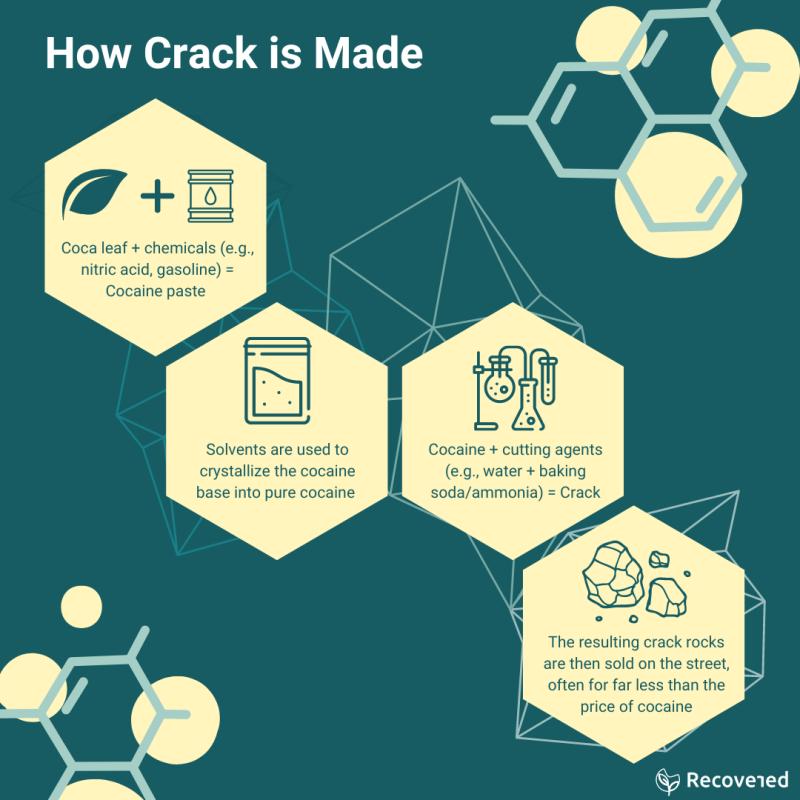Like most illicit drugs, crack cocaine is manufactured in labs and other facilities sometimes referred to as “kitchens”. Crack is made by mixing pure cocaine with a variety of chemicals (e.g., ammonia, sodium bicarbonate) in a process known as “cooking”.
- Crack is made by "cooking" cocaine (a drug created from the coca plant) and many other chemicals and substances known as cutting agents.
- Additional substances (cutting agents) that are commonly added to crack include other stimulants like methamphetamine or Adderall, as well as potent opioids like Fentanyl which can make the drug more harmful.
- There are also many other chemical components in crack, many of which arrive in the substance during the initial stages of creating powdered cocaine.
.jpg?v=1722502281)
What is crack made of?
Crack is made by boiling a mixture of powder cocaine, water, and baking soda (sodium bicarbonate) or ammonia. This process removes the hydrochloride from the pure form of cocaine, creating a solid substance that is then broken down into small rocks. As hydrochloride has been removed from the cocaine, the rocks are smokable.
This process produces what is known as cooked crack which is sold as crack cocaine by drug dealers. There are also many other chemicals and substances that dealers and manufacturers will cook into crack to increase their product volume and replicate the effects of pure cocaine. These are known as cutting agents and can make the drug more harmful.

Powder cocaine, meanwhile, originated from coca leaves and is chemically treated in multiple stages with substances such as nitric acid, lime, gasoline, alcohol, and other chemicals.
What else goes into crack?
When crack is cooked, it usually has additional chemicals or substances added to it, the most common of which are Adderall or Fentanyl. There are two primary reasons that drug dealers use cutting agents for crack:
- To increase the quantity of the drug.
- To enhance the effects of the drug.
Both of these involve additional chemicals that can be harmful to those who take the drug.
Chemicals used to enhance the quantity being produced can range from relatively harmless baby powder to hazardous cleaning products and laundry detergents. Other substances that can be used as cutting agents in crack cocaine include:
- Other stimulants like methamphetamine or Adderall. Smoking crack that has been cut with other stimulants can lead to an increased heart rate and risk of a heart attack.
- Potent opioids like Fentanyl. Opioids like fentanyl are responsible for over 70% of overdose deaths and can be extremely dangerous even in small quantities.
- talcum powder
- caffeine
- levamisole (a drug used in veterinary medicine)
- Numbing agents like benzocaine or lidocaine
- Oxycodone and other opioids
As well as making crack more dangerous, these substances can also affect how crack smells and tastes.
Other chemicals used in the manufacturing of cocaine
There are also many other chemical components in crack, many of which arrive in the substance during the initial stages of creating powdered cocaine. Powdered cocaine is often mixed with a variety of chemicals such as ethyl acetate, acetone, and butyl during production. These chemicals, which often smell like solvents or nail polish, end up in crack when it is cooked.
Some chemicals used in cocaine manufacturing that end up in crack include:
- kerosene
- Lime
- sulfuric acid
- calcium chloride
- cement
- acetic acid
- motor oil
- gasoline
What crack does to the body
Long-term crack abuse can lead to many health problems such as respiratory and heart problems, as well as negatively affecting mental health. It is associated with complications such as:
- “Crack lung” or an acute pulmonary injury
- Heart attack or heart diseases
- Mental health issues such as anxiety, severe depression, and increased suicide attempts
- Dependence and addiction
How is crack used?
Crack is typically smoked with the use of paraphernalia such as pipes, bongs, and other homemade devices. Smoking delivers large quantities of the drug into the lungs and produces a potent and immediate effect.
Getting help for crack addiction
Once crack addiction has formed, it is incredibly hard to get free of the drug, especially when crack is constantly in the system through prolonged use. Fortunately, there are many rehab facilities and addiction treatment centers across the country that are able to help.
Rehab centers, in either an inpatient or outpatient setting, can provide assistance with detox, therapy, and long-term treatment plans to ensure recovery is successful. Find a treatment provider today to help beat addiction.


-guide-detail.jpg?v=1722502712)
-guide-detail.jpg?v=1722503200)
